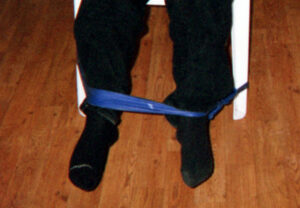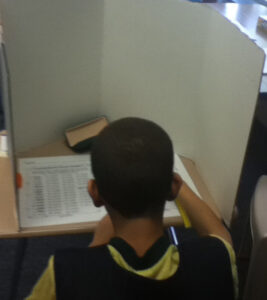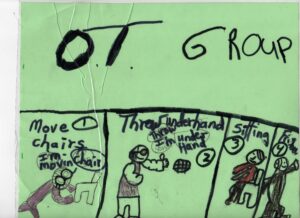Despite the objections from some professionals a multidisciplinary approach may be needed to help youth with complex behavioral challenges. An individualized program may be required for youth who have developmental, sensory, behavioral and mental health challenges. I developed the FAB (Functionally Alert Behavior) Strategies® curriculum as a foundation for environmental adaptation, sensory modulation, positive behavior support, and physical self-regulation strategies. A brief photo introduction of this curriculum was previously presented in my FAB Research Post
For way too long professionals have been splitting children and teens into pieces and arguing over which pieces are owned by their profession. Professionals have also been arguing that their pieces of the puzzle are the most or only important treatment component. The FAB Strategies® photo gallery shows my vision of an integrated approach to helping preschoolers through young adults with complex behavior challenges Scroll down to FAB Strategies® Photo Gallery after clicking HERE
The FAB Strategies® photo gallery begins with the FAB Strategies® form of multidisciplinary interventions that parents, teachers and therapists can use to individualize a program for youth with complex behavioral challenges so they can all literally be on the same page FAB STRATFORMColorMaster The strategies designated in bold are to be developed and taught to other team members by Occupational, Physical, and Speech/Language therapists who determine they are consistent with their goals and scope of practice. This post will highlight the environmental adaptation strategies depicted in red.
The Environmental Adaptation strategies are the first section of the FAB Strategies® form. The Environmental Adaptations strategies are the foundation of the individualized FAB Strategies program to improve behavior. The classroom and treatment room environment are a crucial yet often ignored component for improving behavior. The second picture depicts two environmental adaptation strategies, sit separate and exercise band tied around the chair legs. Sit separate is suggested by recent research and simply involves placing the desk of a student with special needs further away from the desks around it to decrease sensory distractions from peers.
The sit separate strategy is based on recent neurological research validating Ayres’ Sensory Integration theory that some students with Autism Spectrum and Sensory Sensitivity Disorder have significant neurologically-based increases in responsiveness to insignificant sensory input and decreased habituation (ability to get use to) sensory input (Green et al., 2018; Green et al., 2015). Placing the student’s desk further away from peers decreases the chances of problematic tactile, auditory, and combined distractions.
The picture below shows both the sit separate strategy of a desk that is further from peers, but an exercise band attached to the legs of the chair. These adaptations to the desk increase seated attention by decreasing distractions while allowing students to fidget with their legs, move, and receive deep pressure input while seated.

The next environmental adaptation is the study carrel, listed in the first row to the right as Sit Carrel. This can be made by using poster board and making two small cuts enabling it to bend. It can help students who are easily visually distracted or in very busy classrooms focus on their work by blocking outside distractions. If the student frequently misbehaves place it on the floor around their desk so the teacher can see over it.

Research in reducing distractions also supports that thicker walls between classrooms that minimize auditory distractions improve learning in students with Autism Spectrum Disorders (Kinnealey et al., 2012). Repeated research shows the value of both reducing extraneous stimuli that distracts from learning and accentuating sensory input that accentuates curriculum content.
Research supports that environmental adaptations accentuating learning materials (e.g., highlighting key information, using fidgets while problem solving, active movement based learning) facilitated learning in some students with ADHD significantly more than Ritalin (Zentall et al., 2013). I would further argue that it should be considered that there is less research done in adaptive equipment than on drugs because there is less money to be made. At the same time, there is less potential of negative effects from adaptive equipment that facilitates learning than the use of drugs at young ages.
The Photo gallery picture in the environmental adaptation section is a visual schedule. The visual schedule is particularly helpful for students with developmental and sensory challenges who respond better to pictures than words. Visual schedules improve behavior in both special needs and regular classrooms (Macdonald et al., 2018). The visual schedule pictured below was done in comic form by my OT small group.

Each group member identified a general step the group regularly follows in OT group, and drew it as a comic. The group then reviews this visual schedule they constructed before and after each group. The visual schedule facilitates a preview and review in pictures of the general sequence of group activities and expectations for group member behavioral expectations.
Environmental adaptations that decrease auditory and visual distractions as well as simultaneously increase
This post describes the importance of a multidisciplinary approach that addresses all the needs of youth with complex behavioral challenges. The first picture in the photo gallery presents the FAB form guiding the four major areas included in an individualized program of strategies to improve behavior. Next, photo gallery pictures of the environmental adaptation section are described.
Future posts will sequentially describe The sensory modulation, positive behavior support, and physical self-regulation strategies and their photo gallery pictures. I hope they are helpful for guiding integrated multidisciplinary treatment planning for your students who have complex behavior challenges. I welcome your comments and questions. This approach is described in my book FAB Functionally Alert Behavior Strategies.
References
Green SA, Hernandez L, Tottenham N, Krasileva K, Bookheimer SY, Dapretto M. Neurobiology of sensory over-responsivity in youth with autism spectrum disorders. JAMA Psychiatry. 2015;72(8):778-786.
Green SA, Hernandez LM, Bowman HC, Bookheimer SY, Dapretto M. Sensory over-responsivity and social cognition in ASD: Effects of aversive sensory stimuli and attentional modulation on neural responses to social cues. Developmental cognitive neuroscience. 2018 Jan 1;29:127-39.
Kinnealey, M., Pfeiffer, B., Miller, J., Roan, C., Shoener, R., & Ellner, M. L. (2012). Effect of classroom modification on attention and engagement of students with autism or dyspraxia. American Journal of Occupational Therapy, 66, 511–519.
Macdonald L, Trembath D, Ashburner J, Costley D, Keen D. The use of visual schedules and work systems to increase the on‐task behaviour of students on the autism spectrum in mainstream classrooms. Journal of Research in Special Educational Needs. 2018 Oct;18(4):254-66.
Zentall, S. S., Tom-Wright, K., & Lee, J. (2013). Psychostimulant and sensory stimulation interventions that target the reading and math deficits of students with ADHD. Journal of attention disorders, 17(4), 3
